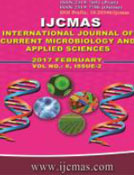


 National Academy of Agricultural Sciences (NAAS)
National Academy of Agricultural Sciences (NAAS)

|
PRINT ISSN : 2319-7692
Online ISSN : 2319-7706 Issues : 12 per year Publisher : Excellent Publishers Email : editorijcmas@gmail.com / submit@ijcmas.com Editor-in-chief: Dr.M.Prakash Index Copernicus ICV 2018: 95.39 NAAS RATING 2020: 5.38 |
Carbapenamse Resistant Enterobacteriaceae (CRE) have disseminated widely since being first reported in 2001. CRE often carry genes that confer high levels of resistance to many other antimicrobials. So they are usually resistant to all β-lactam agents as well as most other classes of antimicrobial agents. The treatment options for patients infected with CRE are very limited. Healthcare-associated outbreaks of CRE have been reported. The aim of this work is to know the prevalence of CRE Escherichia coli and Klebsiella pneumoniae in hospitalized high-risk ICU patients using chromogenic agar and CDC laboratory protocol for CRE detection, in order to implement infection control measures efficiently in order to prevent emergence of hospital-based outbreaks of carbapenemase producing organisms in a tertiary care university hospital. This point prevalence study was conducted in two weeks duration. Fifty four stool specimens were collected from ICU patients. CRE were detected in 38 out of 54 (70.4%) of isolates by chromogenic agar and CDC laboratory protocol for CRE detection. Out of 38 isolates 32 (59.2%) were positive for carbapenemase activity by ertapenam susceptibility and MHT. Chromogenic CRE agar and meropenem susceptibility had a perfect agreement in detecting all resistance mechanism for carbapenems and ertapenam susceptibility and MHT had a perfect agreement in detecting carpabenemse producing Enterobacteriaceae.
 |
 |
 |
 |
 |